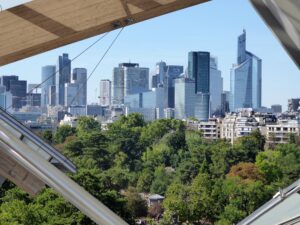
By Ellen Shubart, Class of 2006
If you, like me, have been to Paris a number of times, you think you know all the “good stuff” of architecture and art. Last summer Richard and I visited some new- to-us exciting architecture, and it was a mind-blowing experience. If you have not been recently, you don’t want to miss these. And those of you who go often and know these places—why didn’t you say so sooner?!!
Tadao Ando: Bourse de Commerce – Collection Pinault
The 1763–67 Commodities Exchange began as a grain market and became a stock/corn exchange in 1885. The building sports a classical entrance surrounded by columns and sculpted figures. Inside, the remodeled exchange features a modern art collection in a sleek, contemporary setting designed by Japanese architect Tadao Ando.

Similarly to his work in Chicago at 724 Wrightwood, Ando inserted a set of concrete walls and stairs into the existing building. The main wall is twenty-nine meters wide, with a nine meter, cylindrical structure in the rotunda. The interior room, featuring an art piece of an electric light on a metal grid, leads to other galleries.

Concrete staircases lead the visitor through the building. A walkway on top of the rotunda wall offers views of the glass oculus-roof, and 19th-century murals on the underside of the dome depict trade between the earth’s five continents. The building also includes a 284-seat auditorium, a black-box style studio, and on the third level, a restaurant that overlooks the city — which we unfortunately missed.

Frank Gehry: Fondation Louis Vuitton
For some, this museum by Frank Gehry is “too much.” One critic said it could have done, “without the nautical flourishes.” But could it? What is Frank Gehry without flourishes?
Dating from 2014, the museum is located in the Bois de Boulogne, a 25-minute Metro ride from Paris, plus a walk from the station. It abuts a children’s amusement park that Gehry says gave him inspiration. The building was designed to feature the Louis Vuitton Foundation’s collection of contemporary art.


The building, with huge, sail-like appendages, provides two visual experiences: viewing the artworks inside and panorama views of Paris including the Eiffel Tower from outdoor roof-top terraces. The building is huge and has a huge water feature, too, but it was turned off because of the summer’s drought.

Those “sails” offer many roof terraces. Not surprisingly, they “require advanced software to make” them. They incorporate 3,600 glass panels and 19,000 panels of Ductal, an ultra-strength concrete reinforced with fibers. Most of the sail space is not designed for viewing art.
Art is found in the center of the Fondation’s building, where we saw an excellent exhibit of textiles. Officially, there are 11 art gallery halls and a concert hall that can accommodate up to 1,000 people.
I’m not an art critic, but I found this museum intriguing: the artwork was interesting and had space – lots and lots of space – for display. The sails were invigorating, and the views were spectacular. It is truly a Gehry in all of its senses – and that means a bit of overblown-ness but for the right reason—to show off Paris as well as its art.
Jean Nouvel: The Musee du Quai Branly – Jacques Chirac
Located near the Eiffel Tower, this museum encompasses indigenous arts and crafts from Africa, Asia, Oceania, and the Americas—from everywhere but Western Europe. The museum’s information says the collection includes an incredible 370,000 works. Obviously, not all are on display, but the those on view range from fabrics to weapons, from costumes to cutlery. Inside, the lighting is cool and dim to protect the artifacts. Inside and out, the building is spectacular.

Redesigning this former quai – pier – Jean Nouvel used the window positions to allow surrounding greenery to act as natural backdrop. The original collection dates from the 19th century and were mostly colonial “finds” brought to Paris for display. With new interpretation, the collections were reorganized and pulled together into a single one, focused on different cultures. Opening in 2006, the Musee du Quai Branly had Jacques Chirac’s name appended in 2016.

The museum complex includes a series of buildings and a garden with a lovely restaurant. The main structure measures close to 12,000 square feet, with a 200-meter long by 12-meter tall “living wall” covering the northwest façade, designed by Dr. Patrick Blanc, a French botanist. In some places, the plants come into the building, sprawling down the interior walls.

The setting along the Seine is quiet and peaceful, and the collection of indigenous art is incomparable.
CLICK HERE for more stories on The Bridge.


Thanks so much for this. Places to add to the next trip!
Thanks for sharing. Paris is always exciting and new.
Beautiful glimpse of more to see in Paris! Suzy Ruder
Ellen: Thanks for showing us there’s good stuff — like Gehry’s Fondation Louis Vuitton — besides the Eiffel Tower, Louvre, and sampling croissants along the Seine.